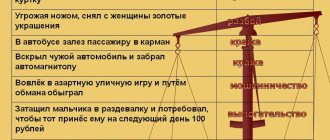In Russian criminal law, theft, robbery, robbery are illegal acts against property. They were committed by theft for personal gain. Theft is the secret theft of property. Robbery is an open act. It is also aimed at appropriating someone else's property. Robbery is an attack. Its purpose is also the theft of someone else's property, which is committed with the use of violence that is dangerous to health or life, or under the threat of such action.
All these crimes have one thing in common. They are aimed at taking possession of other people's property.
What is the difference between robbery and robbery
The legislation of the Russian Federation states that theft, robbery and robbery are different crimes that have a number of distinctions. Among them:
- Dangerous act for the public. During the commission of a robbery, the criminal encroaches on property, and violent actions are used against the victim that threaten his health or life. For this reason, another object of the offense is human life. But during a robbery, the criminal takes possession of property, but at the same time nothing threatens the health and life of a person.
- Intent. If a criminal, when committing a theft, deliberately uses violence that can harm the health and life of the victim, then this act must be classified as a robbery. But during a robbery, violence may not be used.
- Dangerous consequences. A robbery is considered to have taken place after the commencement of illegal actions. At the same time, it doesn’t matter at all whether the job is completed or not. Robbery is characterized by material content, that is, the criminal has the opportunity to dispose of what he managed to steal.
- The method of committing the act. Robbery will be qualified if the offender used objects dangerous to human health and life - weapons. In addition, in Russian legislation, objects that can cause harm to health are equated to weapons used in theft, robbery and robbery. The victim must be aware of the threat to her life. If at the time the crime was committed it became clear that the weapon was not real and would not cause harm, then the crime is classified as robbery.
Robbery
According to Part 1 of Art. 162 of the Criminal Code of the Russian Federation should qualify an attack with the aim of taking possession of property, committed with the use of violence dangerous to life or health, which, although it did not cause harm to the health of the victim, however, at the time of use created a real danger to his life or health.
Robbery is considered completed from the moment of the attack for the purpose of stealing someone else's property
committed with the use of violence dangerous to life or health, or with the threat of such violence.
If the victim was inflicted serious harm to health, which resulted in his death due to negligence, the act should be classified as a set of crimes - under paragraph “c” of Part 4 of Art. 162 and part 4 of article 111 of the Criminal Code of the Russian Federation. If the taking of property was accompanied by a threat of violence
, which was of an uncertain nature, the question of recognizing a person’s actions as robbery or robbery must be decided taking into account all the circumstances of the case: the place and time of the crime, the number of attackers, the nature of the objects with which they threatened the victim, the subjective perception of the threat, the commission of any specific demonstrative actions , indicating the intention of the attackers to use physical violence, etc.
If, during the theft of someone else’s property, a violent restriction of freedom is applied to the victim, the issue of recognizing the person’s actions as robbery or robbery must be decided taking into account the nature and degree of danger of these actions to life or health, as well as the consequences that have occurred or could occur (for example, leaving a tied victim in a cold room, depriving him of the opportunity to seek help).
commits murder of the victim during a robbery
, - qualify under paragraph “h” of Part 2 of Art. 105 of the Criminal Code of the Russian Federation, as well as under paragraph “c” of Part 4 of Art. 162 of the Criminal Code of the Russian Federation.
When qualifying the actions of the perpetrator under Part 2 of Art. 162 of the Criminal Code of the Russian Federation, courts should, in accordance with the Federal Law of November 13, 1996 “On Weapons” and on the basis of an expert opinion, establish whether the object used in the attack is a weapon intended to defeat a living or other target. If so, additional qualification under Art. 222 of the Criminal Code of the Russian Federation.
Objects used as weapons should be understood as objects that could cause bodily harm to the victim that are dangerous to life or health (a penknife or kitchen knife, a razor, a crowbar, a baton, an ax, a flare gun, etc.), as well as objects , intended for temporary destruction of a target (for example, mechanical sprayers, aerosol and other devices equipped with tear and irritant substances).
If a person only demonstrated a weapon or threatened with a obviously unusable or unloaded weapon or an imitation weapon, for example a dummy pistol, a toy dagger, etc., without intending to use these objects to cause bodily harm dangerous to life or health, his actions (in the absence of other aggravating circumstances) taking into account the specific circumstances of the case should be qualified under Part 1 of Art. 162 of the Criminal Code of the Russian Federation, or as robbery, if the victim understood that he was being threatened with an unusable or unloaded weapon or an imitation weapon.
When a person who committed a robbery or assault had the goal of taking possession of property on a large or especially large scale, but actually took possession of property whose value does not exceed two hundred and fifty thousand rubles or one million rubles, his actions should be qualified, accordingly, under Part 3. Art. 30 of the Criminal Code of the Russian Federation and clause “e”, part 2 of Art. 161 or according to paragraph “b” of Part 3 of Art. 161 or under Part 3 of Art. 162 or under clause “b”, part 4, article 162 of the Criminal Code of the Russian Federation.
When determining the amount of stolen property, one should proceed from its actual value at the time of the crime.
. In the absence of information about the price, the value of the stolen property can be established on the basis of expert opinions.
What is the difference between robbery and robbery
When investigating these property crimes, it is necessary first of all to study the place where the theft took place. There it is also necessary to look for traces that could have remained from the kidnapper, subject to careful examination. Therefore, one of the main investigative measures is to inspect the scene of the theft, where any traces of the attacker can be found, including biological ones (fingerprints, traces of shoes, clothing, personal items, cigarette butts). All discovered items must be properly removed from the scene and entered into the protocol. After which the traces must be examined to find the possible thief or his accomplices.
Qualifying features
Crimes in jurisprudence are described using common features - qualification criteria.
These may vary depending on the identity of the attacker. For example, if the thief is a family member (a person living in the same apartment with the victims), then some of the signs disappear due to natural circumstances. Theft with penetration is characterized by the following features:
- penetration by damaging structures;
- mastery of items of property, including intellectual property;
- possible damage to property, increasing losses.
For information: in addition to apartment thefts, there are other thefts committed by breaking and entering. For example, automobiles.
With penetration (burglary)
Forcible entry into a premises has its own signs, identified during the examination of the crime scene. They are:
- broken (damaged) locks on doors or windows;
- alarm system disabled;
- unauthorized disconnection of the apartment from energy sources.
For information: in law enforcement practice there are more dangerous methods of penetration:
- explosions of door and window openings;
- breaking down walls;
- partial dismantling of ceiling bulkheads, etc.
Hacking is carried out using auxiliary tools, for example, master keys, crowbars, etc. Forcible entry is characterized by damage to areas of a structure for the purpose of committing theft. If nothing is missing, then theft will not be classified.
Other signs
Other signs include the following:
- Committed by a group of persons. These include people: those who entered and removed property;
- prepared auxiliary tools (master keys);
- monitoring the situation outside;
- distracting apartment owners;
- those who conducted surveillance of the crime object and others.
Hint: Damaging property also increases damage.
What is theft
The Criminal Code of the Russian Federation (CC RF) gives the following definition to the concept of “theft”.
This crime is described in Article 158 of the Code as “the secret theft of someone else’s property.”
The jurisdiction of this article extends to all types of property, and the term "secret" implies compliance with any of the following conditions:
- The owner of the stolen property did not know about the commission of this offense.
- This offense was committed either only by the criminal, or in the presence of the criminal’s accomplices or simply persons who did not interfere with the commission of the crime.
- If during the theft there were persons present who were not aware of the illegality of what was happening.
The object of theft is the stolen property, the objective side is the secrecy of the theft, the subjective side is the selfish motive of the offender.
At the same time, the object of theft, according to Article 158, cannot be natural resources in their original form. An attempt to seize such wealth is classified as an environmental crime.
Illegal appropriation of weapons, ammunition, explosives also does not fall under the jurisdiction of Article 158 and is punishable under Article 226 of the Criminal Code of the Russian Federation “Theft of weapons, ammunition or explosives.”
Theft of narcotic or psychotropic substances, in turn, is punishable in accordance with Article 229 of the Code “Theft of narcotic or psychotropic substances.”
Article 158 of the Criminal Code of the Russian Federation provides for the following punishments for various types of theft: fine, correctional labor, restriction of freedom and imprisonment. The same article establishes the main types of theft.
General case of theft (secret theft of someone else's property). Such a crime may be punishable by a fine of no more than 80,000 rubles, imprisonment for a term of no more than 2 years, or forced labor for a period of up to 1 year with the possibility of restricting the freedom of the perpetrator for no more than 2 years.
- Theft committed by a group of people in conspiracy.
- Theft with illegal entry of a criminal into a premises or storage facility. The term “premises” in this case is interpreted as a building in which people or material property can be temporarily located, and “storage” is interpreted as structures that are not residential buildings that contain exclusively material property.
- Theft causing serious damage to the victim. The scale of damage is determined by the court, but it cannot be less than 5,000 rubles.
- Theft from an object located near the victim and belonging to him.
For these types of theft the following may be applied as a preventive measure:
- a fine not exceeding 200,000 rubles or the earnings of the convicted person for a period of time not exceeding 18 months;
- correctional labor for up to 5 years;
- imprisonment for a term of up to 5 years with the possibility of additional restriction of freedom for no more than 1 year.
Other types of theft:
- Theft with illegal entry into a home.
- Theft from gas and oil pipelines.
- Grand theft. At the same time, “large size” is defined as an object with a price exceeding 250,000 rubles, and “especially large” is defined as property worth more than 1,000,000 rubles.
These types of theft are punishable by a fine of up to 500,000 rubles or in the amount of the perpetrator’s income for a period of no more than 3 years, forced labor for up to 5 years, or imprisonment for up to 6 years with the possible imposition of a fine and restriction of freedom.
The most severe punishment under Article 158 is provided for theft as part of an organized group and theft on an especially large scale.
Such a crime is punishable by imprisonment for a term of up to ten years with payment of a fine of up to 1,000,000 rubles or in the amount of the income of the convicted person for the last 5 years.
The terms of imprisonment, correctional labor and the amount of the fine are determined by the court.
How to report a theft to the police? Read about it here.
Group of persons
When qualifying the actions of the perpetrators as theft of someone else’s property by a group of persons by prior conspiracy, it is necessary to clarify
1) whether such a conspiracy of accomplices took place before the commencement of actions directly aimed at stealing someone else’s property,
2) whether there was an agreement on the distribution of roles for the purpose of carrying out criminal intent
3) and also what specific actions were committed by each perpetrator and other accomplices of the crime. The verdict must evaluate the evidence regarding each perpetrator of the crime committed and other accomplices (organizers, instigators, accomplices).
If the organizer, instigator or accomplice did not directly participate in the theft of someone else’s property, the crime committed by the perpetrator cannot be qualified as committed by a group of persons by prior conspiracy - qualification with reference to Article 33 of the Criminal Code of the Russian Federation.
The actions of a person who was not directly involved in the theft of someone else's property, but who contributed to the commission of this crime with advice, instructions, or who promised in advance to hide traces of the crime, to remove obstacles not related to providing assistance to the direct perpetrators of the crime, to sell the stolen property, etc., should be qualified as complicity in the act in the form of complicity with reference to Part 5 of Art. 33 of the Criminal Code of the Russian Federation.
Criminal liability for crimes committed by a group of persons by prior conspiracy
, also occurs in cases where, according to a preliminary agreement between the accomplices, the direct seizure of property is carried out by one of them, and the other participants, in accordance with the distribution of roles, committed concerted actions aimed at providing direct assistance to the perpetrator in committing the crime (for example, the person did not enter the home , but participated in the breaking of doors, locks, bars, according to a pre-arranged agreement, took out the stolen property, insured other accomplices from the possible discovery of the crime being committed), what they did is co-perpetrator and does not require additional qualifications under Article 33 of the Criminal Code of the Russian Federation.
When qualifying the actions of two or more persons who stole someone else's property by K, G or R by a group of persons by prior conspiracy or by an organized group, it should be borne in mind that in cases where a person who was not in the conspiracy, during the commission of a crime by other persons, took participation in its commission, such a person should bear criminal liability only for specific actions committed by him personally. The actions of persons who stole someone else's property by K, G or R by a group of persons by prior conspiracy or by an organized group should be qualified under the relevant paragraphs of Articles 158, 161 and 162 of the Criminal Code of the Russian Federation, if two or more perpetrators jointly participated in the commission of this crime, who, by virtue of Article 19 of the Criminal Code of the Russian Federation are subject to criminal liability for their actions.
If a person has committed (including organized a crime or incited to commit) theft, robbery or robbery through the use of other persons who are not subject to criminal liability due to age, insanity or other circumstances, his actions (in the absence of other qualifying criteria) should be qualified in parts the first of Articles 158, 161 or 162 of the Criminal Code of the Russian Federation as the actions of the direct perpetrator of the crime (part two of Article 33 of the Criminal Code of the Russian Federation).
Committing a crime by a group of persons without prior agreement
qualified and may be recognized by the court as an aggravating circumstance.
If the intent of the perpetrators who committed a robbery by a group of persons by prior conspiracy included the use of weapons or objects used as weapons
, all participants in the crime committed are also liable under paragraph “d” of part two of Article 162 of the Criminal Code of the Russian Federation as co-perpetrators even in the case when weapons and other objects were used by one of them. In cases where a group of persons previously agreed to commit the theft of someone else’s property, but one of the co-perpetrators went beyond the scope of the agreement, committing actions that are subject to legal assessment as robbery or robbery, what they did should be qualified under the relevant paragraphs and parts of Article 161, 162 of the Criminal Code of the Russian Federation.
Commitment of these crimes by an organized group
recognized in cases where it involved a stable group of persons who had united in advance to commit one or more crimes (part three of Article 35 of the Criminal Code of the Russian Federation).
Unlike a group of people who have agreed in advance to commit a crime together, an organized group is characterized by
, in particular,
1) stability,
2) the presence of an organizer (leader) in its composition
3) a pre-developed plan for joint criminal activity,
4) distribution of functions between group members in preparation for committing a crime and carrying out criminal intent.
The stability of an organized group can be evidenced not only by the long period of its existence, the repeated commission of crimes by group members, but also by their technical equipment, the duration of preparation of even one crime, as well as other circumstances (for example, special training of members of an organized group to enter a storage facility to seize money (currency) or other material assets).
If these crimes are recognized as committed by an organized group, the actions of all accomplices, regardless of their role in the crime, are subject to qualification as co-perpetrators without reference to Article 33 of the Criminal Code of the Russian Federation. If a person incited another person or group of persons to create an organized group to commit specific crimes, but did not directly participate in the selection of its participants, planning and preparation for committing crimes (crimes) or in their implementation, his actions should be qualified as complicity in the commission of an organized crime. group of crimes with reference to Part 4 of Art. 33 of the Criminal Code of the Russian Federation (incitement).
According to Article 17 of the Criminal Code of the Russian Federation, in the event of a combination of crimes, a person bears criminal liability for each crime committed under the relevant article or part of an article of the Criminal Code of the Russian Federation; punishment is assigned separately for each crime committed. In this case, the final punishment in accordance with Part 2, 3 Art. 69 of the Criminal Code of the Russian Federation cannot exceed more than half the maximum term or amount of punishment provided for the most serious crime committed.
Continuing theft, consisting of a number of identical criminal acts committed by taking someone else’s property from the same source, united by a single intent and collectively constituting a single crime, should be distinguished from a set of crimes.
How robbery differs from theft Concept and signs of robbery and theft
- Part 2: Committed by a group of criminals by prior conspiracy (2 or more people).
- Illegal (open or secret) intrusion into the home or other personal premises of the victim. The purpose of the theft is initial before the fact of the invasion.
- Inflicting significant damage to the victim - for an equivalent amount of not less than 2.5 thousand rubles.
- The theft was committed from clothing, a backpack, a handbag or other hand luggage that was with the victim.
- In large quantities.
- Particularly large volume.
Qualification of crimes
The main qualifying feature of burglary is the secret theft of certain items or funds. The same applies to theft from premises.
Evidence of a crime includes:
- damaged lock;
- broken door or alarm;
- Pre-de-energized premises.
Burglary can be carried out using any other means, but its purpose must certainly be the theft of other people's items or money.
Penetration into a home means the illegal and physical presence of a citizen in it.
Also, the fact that the attacker planned in advance to commit the offense in order to seize other people’s property must be proven in court. If a citizen ends up in someone else’s apartment due to a combination of some insurmountable circumstances, then there will be no corpus delicti.
Entry into premises refers to the physical presence of a person on someone else’s property. This usually happens with the use of special devices - magnets or hooks.
Important! Entry is not recognized if the citizen who carried it out had one-time or permanent access to a residential premises or storage facility.
Signs of a skilled robbery
When committing an open theft, the criminal relies on the suddenness of his actions, as well as the confusion of victims and eyewitnesses.
In the case of violent robbery, the offender, in order to take possession of someone else's property or retain it, uses physical violence against persons who interfere with his actions.
The first sign of a skilled robbery is the possibility of the offender using both physical and mental violence. Mental violence is expressed in the threat of physical violence.
The second sign is that in the process of robbery, violence can be applied not only to the owner of the property, but also to third parties who may interfere with the theft.
The third sign of violent robbery is exclusively a method of violence in which there is no danger to the health and life of the victim.
The question arises: - What is violence that does not pose a danger to the health and life of the victim?
Answer - Violence that does not pose a threat to health and life implies actions that did not cause real damage to the victim’s health and did not create a threat to his life, and also did not lead to loss of ability to work (even short-term), but caused physical pain (beating) or freedom was limited.
Minor health hazards include injuries such as abrasions, bruises, and small wounds. That is, minor damage, the consequences of which last no more than six days. Also included in this category is a slight ailment that leaves no visible traces.
Let us note that in judicial practice regarding robbery there is no stable concept of violence that does not pose a danger to the health and life of the victim. This fact certainly makes it difficult to qualify such crimes.
For example, according to the resolution of the Plenum of the Supreme Court of the Russian Federation dated August 18, 1992, violence that poses a danger to life and health also includes violence that, at the time of its commission, created a danger to the health and life of the victim, even if it did not cause him significant harm .
Regarding the restriction or deprivation of freedom of the victim, it can be regarded as violence that did not cause a danger to health if the actions of the offender were aimed at preventing the victim from preventing the theft of property.
If the offender used physical force on the victim’s property, for example, tore a hat from his head, snatched a bag or purse from his hands, then his actions will not be classified as violence.
Robbery can be considered committed if the criminal has a real opportunity to dispose of the property as he wishes, even if he did not have time to realize his intentions.
Signs of burglary
It is legally stated that breaking into premises and illegally entering them occurs with the aim of taking possession of someone else's property. Part 2 of Article 158 of the Criminal Code of the Russian Federation pays special attention to the qualifying elements of the crime:
- The act was committed by a group of persons who previously agreed among themselves;
- The citizen who has become a victim of theft has suffered significant material damage;
- There is the very fact of unauthorized entry into someone else's home.
It is worth noting that the rules on entry into premises without the knowledge of the owner will also include those cases. When property is stolen using special devices without the physical presence of the attacker in the apartment. Such devices can be a variety of hooks, magnets, fishing rods, etc.
Quite often there are situations when a crime is committed by several attackers. In this case, the court will establish liability to a greater extent, and the case itself will be classified according to the characteristics of a criminal group.
Advice from a lawyer on how to reclassify an act during the investigation and in court
As practice shows, when sending a criminal case to court, the investigator often classifies the crime “with reserve”, that is, under a more serious article for certain reasons:
- Traditionally, the effectiveness of law enforcement agencies is assessed by the number of serious crimes solved and sent to court. The investigator, as a rule, is not interested in what qualifications will be indicated in the verdict.
- Since the deterioration of the defendant’s position during the consideration of the case in court is not allowed, if the qualifications are dubious, the investigator will always act on the principle of “better more than less” and send the case to the court with qualification under a more serious article in the hope that “the court will correct it.”
Reclassification of the case during the investigation seems more problematic, but it is possible.
As a rule, in borderline cases, much depends on the testimony of the defendant himself, since only he can explain the details of his intent, if, of course, he admits guilt.
If the criminal’s intent included committing theft, and the charge was brought for robbery, then it makes sense to admit partial guilt during the investigation. During interrogation as an accused, you should explain your position and, if necessary, submit a request for investigative actions to support it. Let's look at an example.
The young man is accused of committing robbery under the following circumstances. Early in the morning he entered the cafe through a broken window. Having put some gourmet foodstuffs into his bag, he heard the key turn in the lock - the first cook had come to replace him.
The thief quickly climbed out through the window and started running. A cafe employee, turning on the light, saw the chaos, ran to the window, and, noticing a running thief in the distance, began shouting to him to return the stolen goods. According to the cook, he heard him, but still disappeared. Based on this testimony, a charge of committing open theft - robbery was brought.
During the investigation, the accused partially admitted his guilt and testified that he did not hear the cook’s screams and committed theft, that is, secret theft. The lawyer filed a petition to conduct an investigative experiment, during which it turned out that at such a distance the defendant could not hear the cook’s screams. The result was requalification from Art. 161 at station 158 part 2, that is, theft by entering the premises.
During the trial, reclassification to a less serious charge is also possible.
For example, the court heard a case of robbery committed by a group of young people under the following circumstances.
Several college students, being avid fans, attended the football game. After it was over, they met a fan of the opposing team, and a verbal altercation ensued between them, which escalated into a fight. The parties tried to prove to each other with their fists which football team deserved victory more.
The fight was not serious, they wrestled, pushed each other, and separated. After the conflict, a lone fan did not find a cell phone in his jacket pocket. This phone was subsequently seized from one of the college students involved in the conflict. It turned out that the victim took off his jacket before the fight, and one of the attackers pulled out a phone from his pocket. The case was sent to court under Art. 161 part 2, as robbery with the use of violence by a group of persons.
In court, the students' lawyers developed a unified position based on the fact that the cause of the conflict and fight was opposing opinions about football teams. During the fight, no demands were made on the victim; the phone was secretly stolen by one of the company members, who did not inform the others about it.
Violence during a fight was not a means of taking possession of property, which is what distinguishes robbery from theft.
This version was fully confirmed during the judicial investigation. The thief stated that when he saw the jacket lying there, he decided to check his pockets and found a phone. He took the phone for himself without informing others about it, thus committing a secret theft, that is, theft.
As a result, the verdict against him was made under Art. 158 part 2, the remaining participants in the incident were acquitted under Art. 161 part 2, although their actions contained elements of another crime - beatings.
Answering the question: “Theft and theft of other types - what is the difference?” — it is necessary to pay special attention to the intent of the perpetrator, which will help to avoid erroneous classification. .
Punishment and responsibility
The severity and guilt of the suspects is determined by the court. The following measures of influence on the thief are prescribed:
- penalties in the amount of 100 to 500 thousand rubles. or alienation of the thief’s income for three years;
- forced labor for up to five years;
- imprisonment for up to one and a half years.
Attention: the following persons are exempt from liability:
- declared insane (incompetent);
- under fourteen years of age.
Minors
If the crime was committed by a minor child (over 14 years old), then he also faces punishment. Depending on the severity of the crime, the young man faces up to three years in prison . These criminals serve their sentences in specialized (children's) institutions of the criminal correctional system. Important: penalties are imposed on the parent (official representative) of the minor.
What follows for burglary if there has already been a criminal record?
The commission of a criminal act by a convicted citizen is recognized as an aggravating circumstance. More stringent measures apply to him:
- imprisonment for up to six years;
- fine up to 800 thousand rubles;
- restriction of freedom for up to one and a half years.
Hint: if the theft is particularly large, the term can be extended to 10 years.
Liability for false testimony
If an attacker provides false information about an uncommitted crime, he may incur criminal liability (section 306 of the Criminal Code):
- fine up to RUB 120,000.0;
- compulsory work up to 480 hours;
- correctional labor for up to 2 years;
- others.
Hint: a false call to law enforcement leads to administrative liability.
Factors influencing sentence
When making a decision, the court examines all the nuances of the case. The following factors influence his final decision:
- presence of: preliminary agreement between persons, including tacit agreement;
- other aggravating circumstances;
- kidnapped;
Hint: the sentence is commuted if the injured party voluntarily compensates the damage.
What belongs to aggravating circumstances
The court considers the following circumstances of the case to be aggravating:
- high value of stolen goods;
- causing major damage to the victim;
- group conspiracy;
- the thief has an outstanding criminal record;
- involvement of minors in criminal activities;
- the use of weapons and explosives in the process of criminal activity;
- fraud;
- threats.
Hint: repentance softens the sentence.
Arbitrage practice
Example 1 .
Ivankov S. divorced his wife and harbored a grudge against the woman. After waiting for her to leave for a neighboring town, he drove a car to her house and entered the premises. He didn't have the key, so the door had to be broken down. He took out valuables worth RUR 100,000.0, loaded them into the vehicle and drove off. He was fully aware of the criminality of his act. The woman's neighbors called the police. Ivankov fully realized his guilt and returned the valuables. The crime is classified under paragraph “a” of the third part of paragraph 158 of the Criminal Code. The court imposed a sentence of 2 years' imprisonment. Taking into account Article 73 of the Criminal Code, the term was considered suspended.
Example 2 . A fence net worth RUR 10,000.0 was stolen from Sidorova’s dacha. She reported this to law enforcement agencies. Then she independently found out that the thieves were her brother’s friends. The missing property was found at his home. However, a previously convicted friend threatened the young man to write a confession. The woman did not want her loved one to go to prison and turned to a lawyer.
The specialist explained that in this case the fact of kinship can be used. Since she is recognized as a victim, she can formalize reconciliation with her brother. The case will be dismissed either at the preliminary stage or in court.
What is the difference between robbery and robbery
Despite the fact that this is the question that is usually of interest to ordinary citizens, criminal law gives a very clear definition to each composition. Interestingly, the most important element that makes the difference is the health of the victim, and what harm was caused or could be caused to him. Those. during a robbery, the attacker causes harm to the victim’s health that is not life-threatening, or threatens to cause such harm.
Definitions
First of all, let's briefly understand these two concepts and define them.
Robbery
Robbery
Typical examples
For example: citizen A. snatched citizen B.’s purse from her hands and disappeared. It turns out that the victim lost her property, but did not receive life-threatening injuries (or did not hear threats of life-threatening harm to her health). This is an example of a “classic” robbery.
Speaking about robbery, here we are talking about causing life-threatening harm to the victim’s health, or the threat of causing it. It turns out that if, according to the above example, the attacker took possession of the purse after stabbing the victim, then this is already considered robbery. The same applies if the criminal obtained property by threatening to use a weapon. Those. even without harm to health, the crime can be classified as robbery. This means we can safely say that robbery is committed without the use of weapons, and robbery with the use of one. We have figured out the difference between robbery and robbery in their typical forms, and now let’s talk about the difference between violent robbery and robbery.
In turn, theft is also different from robbery and robbery. In we analyze the difference in detail.
What is violent robbery and what is its difference from robbery?
As we have already said, robbery can take several forms:
- without harm to the victim's health
- causing harm (mild to moderate)
- with a threat of harm to health (mild or moderate)
It is the first element from the list that is a kind of extension of the usual robbery, because associated with violence. A simple example: an attacker, in the process of committing a crime, hit a citizen in the jaw. This is violent robbery. The same act, but committed with the use of, for example, brass knuckles, will be considered robbery.
Problems of distinguishing theft, robbery and robbery
Theft from the objective side is expressed in actions and consists of two elements: the seizure of property from the owner or other owner and the circulation of property in favor of the culprit or another person. Mentioning other people's property in the legislative definition of theft is normatively somewhat unnecessary, since other people's property, by definition, is the subject of any theft. In case of theft, the perpetrator has no rights to the stolen property, but the fact that the perpetrator has obligations in relation to this property does not exclude theft. The sign of secrecy of theft (by which, as a rule, theft in practice is distinguished from other forms of theft) refers to the seizure of property; its subsequent open circulation for someone else’s benefit is not significant.
Robbery
It is worth noting that in a case where the victim or other persons notice that property is being stolen, but the criminal himself believes that he is doing it unnoticed, the crime will be classified as theft rather than robbery. However, if after someone noticed that theft was taking place, but the criminal ignored this fact and continued his illegal actions, then in this case secret theft develops into open theft.
Violent robbery occurs when the condition is met that the use of violence or the threat of its use was aimed at taking possession of property or retaining it after taking possession.
If, after the victim or another person notices the theft being committed, after which the criminal uses violent methods against them in order to seize or retain property, then such an act will be classified as violent robbery.
If an attempt to seize property is unsuccessful, it will be considered an attempted robbery.
According to the comments to the Criminal Code of the Russian Federation, the elements of robbery do not form open actions that are aimed at taking possession of someone else’s property for the purpose of its destruction or temporary use, as well as in connection with an alleged or actual right to this property.
Example:
The objective side of robbery is the cause-and-effect relationship between the actions of the perpetrator in order to seize property and the harmful consequences that occur.
The subjective side of robbery presupposes direct intent. That is, the criminal understands that in front of someone he is stealing someone else’s property, and also foresees that his actions cause damage and desires the occurrence of such consequences. In this case, the goal of the criminal is to illegally obtain profit at the expense of some property.
Characteristics of robbery
Violence in a robbery is dangerous to life and health. This is the peculiarity of this crime. It is characterized by causing varying degrees of harm to the physical condition of the victim. The object of robbery is property belonging to another person. From the objective side, the act in question is characterized by the use of violence. The subject of the act in question is a sane person not younger than fourteen years of age. From the subjective side, robbery has direct intent and selfish goals.
The difference between theft and robbery
Robbery is considered violent only if the use or threat of violence served as a means to take possession of property or as a means to retain it immediately after taking possession. The violence that the kidnapper uses to avoid arrest after the theft is completed does not mean it escalates into robbery. Conversely, if the crime began as a non-violent robbery or even theft, but after its discovery the perpetrator used violence to take possession of the property or to retain it immediately after secret or open taking, the act escalates into violent robbery.
Difference from other acts
What is the difference between robbery and robbery? There is a significant difference between robbery and robbery. It manifests itself in a number of factors that you should be aware of. These include:
- When committing a robbery, the main object of the crime is the property of the owner, and during robbery, the object is both valuable things and health, as well as the lives of property owners and other citizens who are present when the unlawful act is committed.
- Intent is also a differentiator in qualifying events. Since before committing a robbery, criminals have a certain intent to cause bodily harm to citizens, during a robbery it may not exist. Offenders do not always plan to use physical force on citizens near valuable property.
- Since a robbery attack is considered committed from the moment it begins, that is, in other words, it has a truncated composition.
It makes no difference whether the illegal act was completed or not. Robbery must be qualified by material elements. This fact means different consequences when the criminal has the opportunity to dispose of the acquired property of others. - Method of committing a crime. Robbery, first of all, includes weapons used in the commission of actions that violate current legislation. This is the use of firearms, as well as objects equated to weapons. These include grenades, knives, crowbars and axes, that is, those objects that can harm people. The robbery is not accompanied by objects that can cause physical injury, and weapons are not used in it.
There is a certain difference in violent robbery and assault related to robbery.
In both the first and second cases, the victim is injured, but the nature of the injuries has certain differences.
The main difference is that a robbery entails a danger to human life and health.
During violent robbery, the maximum impact on the human body is mild harm to health.
Robbery and robbery: what is the difference? Find out from the video:
https://youtube.com/watch?v=sua9PjDeWCs%3Fecver%3D1
What are the qualifying signs of robbery? Read about it here.
Errors in distinguishing between these crimes
It should be understood that a crime that begins as a theft can turn into robbery if the criminal is discovered, and into robbery if he begins to use violence. There is a rather fine line here, which is why victims and witnesses often make mistakes when initiating a criminal case.
A common mistake is to mistake theft for robbery if it was committed in the presence of people. This does not guarantee that the crime is robbery. Those present may not have noticed the theft being committed, may have been intoxicated, and children or the mentally ill may not realize the illegality of the act. We have considered all the significant differences between theft and robbery.
People also often confuse robbery and robbery if the robber had a weapon or an object in his hands that could be used as a weapon. This is another mistake - a crime is considered robbery only if violence is used that damages the health and poses a threat to the life of the victim.
Mistakes with the amount of stolen property to initiate a criminal case are also made quite often.
It is important for each of us to know the main differences in thefts that can happen to anyone. Be vigilant, keep a close eye on your belongings, secure your home as much as possible - and this will protect you from criminals
If the worst happens to you, contact the police immediately. Take care of yourself!
To solve your problem RIGHT NOW get a free LEGAL consultation St. Petersburg
The difference between violent robbery and robbery
The main difference is what kind of violence was used. In both cases, the victim is injured, but their nature is different. In a robbery they are dangerous to his life, but in a violent robbery there is no such danger. Examples to help correctly classify a crime are given below:
- During the theft of a wallet or bag in a public place, the victim notices that a crime is being committed and does everything possible to prevent it. But the criminal continues, pushes the victim and disappears. This crime can be considered robbery.
- A similar situation, but during the theft, the criminal takes out a bat or stick and hits the victim. After such actions, the victim is injured, thereby suffering heavy damage. As a result, such a crime is already classified as robbery.
We have figured out how robbery differs from robbery, and now we will dwell in more detail on the methods of investigation.











